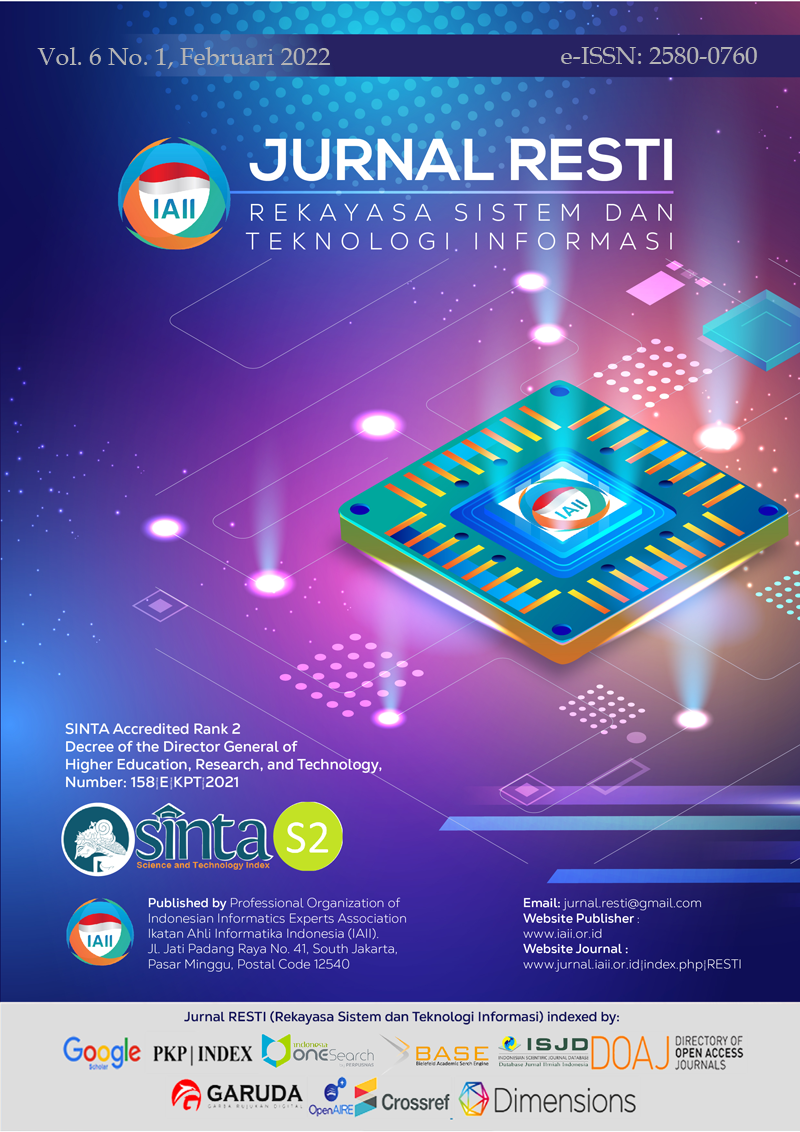Deteksi Penyakit Covid-19 Pada Citra X-Ray Dengan Pendekatan Convolutional Neural Network (CNN)
Detection of Covid-19 Disease in X-Ray Imagery With Convolutional Neural Network Approach (CNN)
Abstract
The Coronavirus (COVID-19) pandemic has resulted in the worldwide death rate continuing to increase significantly, identification using medical imaging such as X-rays and computed tomography plays an important role in helping medical personnel diagnose positive negative COVID-19 patients, several works have proven the learning approach in-depth using a Convolutional Neural Network (CNN) produces good accuracy for COVID detection based on chest X-Ray images, in this study we propose different transfer learning architectures VGG19, MobileNetV2, InceptionResNetV2 and ResNet (ResNet101V2, ResNet152V2 and ResNet50V2) to analyze their performance, testing conducted in the Google Colab work environment as a platform for creating Python-based applications and all datasets are stored on the Google Drive application, the preprocessing stages are carried out before training and testing, the datasets are grouped into theNormal and COVID folders then combined m become a set of data by dividing them into training sets of 352 images, testing 110 images and validating 88 images, then the detection results are labeled with the number 1 means COVID and the number 0 for NORMAL. Based on the test results, the ResNet50V2 model has a better accuracy rate than other models with an accuracy level of about 0.95 (95%) Precision 0.96, Recall 0.973, F1-Score 0.966, and Support of 74, then InceptionResNetV2, VGG19, and MobileNetV2, so that ResNet50V2-based CNNs can be used as initial identification for the classification of a patientinfected with COVID or NORMAL.
Downloads
References
Y. Mohamadou, A. Halidou, and P. T. Kapen, “A review of mathematical modeling, artificial intelligence and datasets used in the study, prediction and management of COVID-19,” Appl. Intell., vol. 50, no. 11, pp. 3913–3925, 2020, doi: 10.1007/s10489-020-01770-9.
M. Ilyas, H. Rehman, and A. Nait-ali, “Detection of Covid-19 From Chest X-ray Images Using Artificial Intelligence: An Early Review,” pp. 1–8, 2020, [Online]. Available: http://arxiv.org/abs/2004.05436.
M. Saqib, S. Anwar, A. Anwar, L. Petersson, N. Sharma, and M. Blumenstein, “COVID19 detection from Radiographs: Is Deep Learning able to handle the crisis?,” no. June, pp. 1–14, 2020, doi: 10.13140/RG.2.2.19939.37924.
L. Wynants et al., “Prediction models for diagnosis and prognosis of covid-19: Systematic review and critical appraisal,” BMJ, vol. 369, 2020, doi: 10.1136/bmj.m1328.
D. Singh, V. Kumar, Vaishali, and M. Kaur, “Classification of COVID-19 patients from chest CT images using multi-objective differential evolution–based convolutional neural networks,” Eur. J. Clin. Microbiol. Infect. Dis., vol. 39, no. 7, pp. 1379–1389, 2020, doi: 10.1007/s10096-020-03901-z.
T. Ozcan, “A Deep Learning Framework for Coronavirus Disease (COVID-19) Detection in X-Ray Images,” 2020, doi: 10.21203/rs.3.rs-26500/v1.
S. H. Kassania, P. H. Kassanib, M. J. Wesolowskic, K. A. Schneidera, and R. Detersa, “Automatic Detection of Coronavirus Disease (COVID-19) in X-ray and CT Images: A Machine Learning Based Approach,” Biocybern. Biomed. Eng., vol. 41, no. 3, pp. 867–879, 2021, doi: 10.1016/j.bbe.2021.05.013.
E. E.-D. Hemdan, M. A. Shouman, and M. E. Karar, “COVIDX-Net: A Framework of Deep Learning Classifiers to Diagnose COVID-19 in X-Ray Images,” 2020, [Online]. Available: http://arxiv.org/abs/2003.11055.
S. Asif, Y. Wenhui, H. Jin, and S. Jinhai, “Classification of COVID-19 from Chest X-ray images using Deep Convolutional Neural Network,” 2020 IEEE 6th Int. Conf. Comput. Commun. ICCC 2020, pp. 426–433, 2020, doi: 10.1109/ICCC51575.2020.9344870.
S. Pathari and U. Rahul, “Automatic detection of COVID-19 and pneumonia from Chest X-ray using transfer learning,” medRxiv, pp. 1–6, 2020, doi: 10.1101/2020.05.27.20100297.
D. Chen, F. Liu, and Z. Li, “A Review of Automatically Diagnosing COVID-19 based on Scanning Image,” pp. 1–12, 2020, [Online]. Available: http://arxiv.org/abs/2006.05245.
A. Abbas, M. M. Abdelsamea, and M. M. Gaber, “Classification of COVID-19 in chest X-ray images using DeTraC deep convolutional neural network,” Appl. Intell., vol. 51, no. 2, pp. 854–864, 2021, doi: 10.1007/s10489-020-01829-7.
A. A. Farid, G. I. Selim, and H. A. A. Khater, “A CNN Classification Model For Diagnosis Covid19,” no. July, 2020, doi: 10.20944/preprints202007.0591.v1.
S. E. Arman, S. Rahman, and S. A. Deowan, “COVIDXception-Net: A Bayesian Optimization-Based Deep Learning Approach to Diagnose COVID-19 from X-Ray Images,” SN Comput. Sci., vol. 3, no. 2, 2022, doi: 10.1007/s42979-021-00980-3.
M. Siddhartha and A. Santra, “COVIDLite: A depth-wise separable deep neural network with white balance and CLAHE for detection of COVID-19,” pp. 1–25, 2020, [Online]. Available: http://arxiv.org/abs/2006.13873.
K. H. Shibly, S. K. Dey, M. T. U. Islam, and M. M. Rahman, “COVID faster R–CNN: A novel framework to Diagnose Novel Coronavirus Disease (COVID-19) in X-Ray images,” Informatics Med. Unlocked, vol. 20, p. 100405, 2020, doi: 10.1016/j.imu.2020.100405.
F. Ucar and D. Korkmaz, “COVIDiagnosis-Net: Deep Bayes-SqueezeNet based diagnosis of the coronavirus disease 2019 (COVID-19) from X-ray images,” Med. Hypotheses, vol. 140, no. April, p. 109761, 2020, doi: 10.1016/j.mehy.2020.109761.
M. Yamac, M. Ahishali, A. Degerli, S. Kiranyaz, M. E. H. Chowdhury, and M. Gabbouj, “Convolutional Sparse Support Estimator-Based COVID-19 Recognition from X-Ray Images,” IEEE Trans. Neural Networks Learn. Syst., vol. 32, no. 5, pp. 1810–1820, 2021, doi: 10.1109/TNNLS.2021.3070467.
T. Majeed, R. Rashid, D. Ali, and A. Asaad, “Covid-19 detection using CNN transfer learning from X-ray Images,” medRxiv, p. 2020.05.12.20098954, 2020, [Online]. Available: https://www.medrxiv.org/content/10.1101/2020.05.12.20098954v2%0Ahttps://www.medrxiv.org/content/10.1101/2020.05.12.20098954v2.abstract.
X. Li, C. Li, and D. Zhu, “COVID-MobileXpert: On-Device COVID-19 Patient Triage and Follow-up using Chest X-rays,” Proc. - 2020 IEEE Int. Conf. Bioinforma. Biomed. BIBM 2020, pp. 1063–1067, 2020, doi: 10.1109/BIBM49941.2020.9313217.
Copyright (c) 2022 Jurnal RESTI (Rekayasa Sistem dan Teknologi Informasi)

This work is licensed under a Creative Commons Attribution 4.0 International License.
Copyright in each article belongs to the author
- The author acknowledges that the RESTI Journal (System Engineering and Information Technology) is the first publisher to publish with a license Creative Commons Attribution 4.0 International License.
- Authors can enter writing separately, arrange the non-exclusive distribution of manuscripts that have been published in this journal into other versions (eg sent to the author's institutional repository, publication in a book, etc.), by acknowledging that the manuscript has been published for the first time in the RESTI (Rekayasa Sistem dan Teknologi Informasi) journal ;








